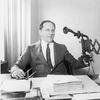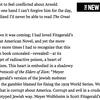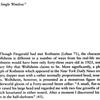4: Image, “American Gambler Arnold Rothstein At His Desk,” 1910s, and text excerpts, “American Shylock/ Arnold Rothstein (1882–1928),” 2012, and "The Merchant of Modernism: The Economic Jew in Anglo-American Literature," 2003.
Many different sources have argued about whether or not F. Scott Fitzgerald based the character of Meyer Wolfsheim on Arnold Rothstein, a real member of the Jewish mafia who, among other crimes, is rumored to have fixed the 1919 World Series.
Suggested Activity: Have students look at the image of Arnold Rothstein while reading the passage where Nick meets Meyer Wolfsheim for the first time. Do students think the description of Wolfsheim from the book matches the image of Rothstein? Why or why not?
Now have students read each of the excerpts. Based on these, do they think that the character of Meyer Wolfsheim was based on Arnold Rothstein? How much does it matter if he was or if he wasn’t? Is the portrayal of Meyer Wolfsheim anti-Semitic? Why or why not? Is it still anti-Semitic if it is based on a real Jewish person? Why or why not?
Ask students if they are familiar with the Jewish mafia. Does the idea of the Jewish mafia confirm or challenge stereotypes they know about Jewish people? Then ask them: what, if any, other Jewish characters have you encountered in works of literature? Did these characters conform to stereotypes about Jewish people? Did they transcend or challenge stereotypes?
Sources: Jack Benton, “American Gambler Arnold Rothstein At His Desk,” photograph, Getty Images, 1910s.
Ron Rosenbaum, “American Shylock: Arnold Rothstein (1882–1928),” the New Republic, October 24, 2012, accessed at https://newrepublic.com/article/109050/american-shylock-arnold-rothstein-18821928.
Gary Martin Levine, The Merchant of Modernism: The Economic Jew in Anglo-American Literature, 1864 –1939 (New York: Routledge, 2003), 113.
Arnold Rothstein
 Download image (97.33 KB)
Download image (97.33 KB) Fitzgerald and Rothstein (Levine)
 Download image (59.33 KB)
Download image (59.33 KB)



